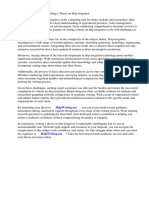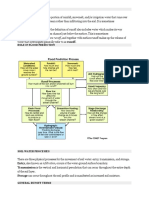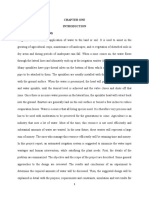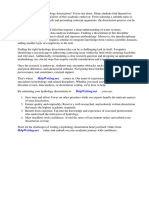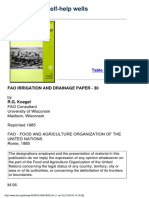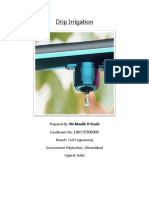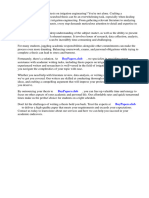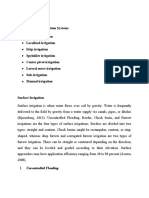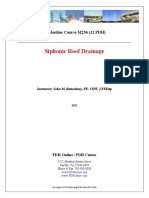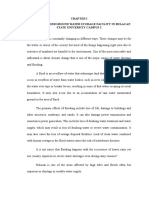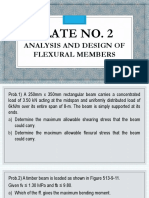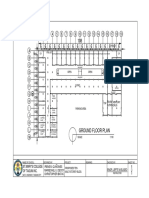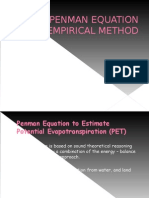0 ratings0% found this document useful (0 votes)
17 viewsNotxt (3) VF
Notxt (3) VF
Uploaded by
Irene B. QuiñonesThis document discusses theories related to drainage and flooding. It explains that soil can absorb water into its pores until it reaches saturation, and excess water will pool on the surface and potentially cause flooding. It also notes that urban drainage systems may become inefficient if more water reaches inlets than they were designed to drain. Finally, it outlines some of the negative impacts of poor drainage and flooding, such as property damage, health issues, and people being displaced from their homes.
Copyright:
© All Rights Reserved
Available Formats
Download as DOCX, PDF, TXT or read online from Scribd
Notxt (3) VF
Notxt (3) VF
Uploaded by
Irene B. Quiñones0 ratings0% found this document useful (0 votes)
17 views2 pagesThis document discusses theories related to drainage and flooding. It explains that soil can absorb water into its pores until it reaches saturation, and excess water will pool on the surface and potentially cause flooding. It also notes that urban drainage systems may become inefficient if more water reaches inlets than they were designed to drain. Finally, it outlines some of the negative impacts of poor drainage and flooding, such as property damage, health issues, and people being displaced from their homes.
Original Description:
vfd
Original Title
notxt(3)vf
Copyright
© © All Rights Reserved
Available Formats
DOCX, PDF, TXT or read online from Scribd
Share this document
Did you find this document useful?
Is this content inappropriate?
This document discusses theories related to drainage and flooding. It explains that soil can absorb water into its pores until it reaches saturation, and excess water will pool on the surface and potentially cause flooding. It also notes that urban drainage systems may become inefficient if more water reaches inlets than they were designed to drain. Finally, it outlines some of the negative impacts of poor drainage and flooding, such as property damage, health issues, and people being displaced from their homes.
Copyright:
© All Rights Reserved
Available Formats
Download as DOCX, PDF, TXT or read online from Scribd
Download as docx, pdf, or txt
0 ratings0% found this document useful (0 votes)
17 views2 pagesNotxt (3) VF
Notxt (3) VF
Uploaded by
Irene B. QuiñonesThis document discusses theories related to drainage and flooding. It explains that soil can absorb water into its pores until it reaches saturation, and excess water will pool on the surface and potentially cause flooding. It also notes that urban drainage systems may become inefficient if more water reaches inlets than they were designed to drain. Finally, it outlines some of the negative impacts of poor drainage and flooding, such as property damage, health issues, and people being displaced from their homes.
Copyright:
© All Rights Reserved
Available Formats
Download as DOCX, PDF, TXT or read online from Scribd
Download as docx, pdf, or txt
You are on page 1of 2
Theoretical Framework
This study supports and uses theories and information in which this
research is base. It allows this research to more understandable and
categorical. The researcher decided to use this theories and approach
that will help in making the objectives and statement of the problem
obsolete. Likewise this given information may help to establish the
methodologies in this study.
During rain or irrigation, the fields become wet. The water
infiltrates into the soil and is stored in its pores. When all the pores are
filled with water, the soil is said to be saturated and no more water can
be absorbed; when rain or irrigation continues, pools may form on the
soil
surface
which
causes
flood
(http://support.optisurface.com/knowledgebase/articles/192123-5surface-drainage-theory). Urban drainage systems may prove locally
inefficient as a consequence of an unexpected amount of water failing
to reach a certain number of inlets in the network. Local failures are
indeed observed as a consequence of precipitation events with even
lower intensities than the design rainfall, when inlets are requested to
drain contributing areas that are larger than the design ones
(http://onlinelibrary.wiley.com/doi/10.1002/hyp.5648/abstract).
Poor drainage can lead to flooding, resulting in property loss, and
people may even be forced to move to escape floodwaters. Flooding
may also damage water supply infrastructure and contaminate
domestic water sources. This contributes significantly to the spread of
diseases such as typhoid and cholera, and may increase the likelihood
of contracting worm infections from soil contaminated by faeces.
(http://www.who.int/water_sanitation_health/hygiene/settings/hvchap5.
pdf)
You might also like
- Group 69 Engineering Team Project (ETP) ProposalDocument15 pagesGroup 69 Engineering Team Project (ETP) Proposalaiman naim100% (2)
- WorkDocument3 pagesWorkIrene B. QuiñonesNo ratings yet
- John Wiley & SonsDocument2 pagesJohn Wiley & SonsIrene B. QuiñonesNo ratings yet
- Rainwater Harvesting Thesis PDFDocument5 pagesRainwater Harvesting Thesis PDFwguuxeief100% (2)
- Water Irrigation ThesisDocument5 pagesWater Irrigation ThesisAndrew Molina100% (2)
- Surface Irrigation Systems Bae 1527Document4 pagesSurface Irrigation Systems Bae 1527Waleed HassanNo ratings yet
- Assignment 6 3 MirnagarzaDocument1 pageAssignment 6 3 Mirnagarzaapi-229219825No ratings yet
- Term Paper On IrrigationDocument7 pagesTerm Paper On Irrigationafdtvuzih100% (1)
- 1.1 Background of The StudyDocument8 pages1.1 Background of The StudyFrederick Perez IINo ratings yet
- Design and Construction of An AutomaticDocument74 pagesDesign and Construction of An AutomaticAbdallaNo ratings yet
- Thesis On Drip IrrigationDocument8 pagesThesis On Drip Irrigationgbwygt8n100% (2)
- Water Irrigation System ThesisDocument8 pagesWater Irrigation System Thesiscarolinafoxpembrokepines100% (2)
- Rainwater HarvestingDocument8 pagesRainwater HarvestingDonna Frias BenitoNo ratings yet
- Feasibility Study Implementation of Rooftop Rainwater Collection For Irrigation of GreenspaceDocument12 pagesFeasibility Study Implementation of Rooftop Rainwater Collection For Irrigation of Greenspaceapi-384085923No ratings yet
- Research Paper On IrrigationDocument5 pagesResearch Paper On Irrigationnaneguf0nuz3100% (1)
- Research Paper On Drip Irrigation SystemDocument7 pagesResearch Paper On Drip Irrigation Systemafnhekkghifrbm100% (1)
- RRL RWH System SpecsDocument5 pagesRRL RWH System SpecsJulianne LavadiaNo ratings yet
- Hydrology Report OutlineDocument5 pagesHydrology Report OutlineAldrin FallerNo ratings yet
- Rainwater Harvesting: Rainwater Harvesting Is The Accumulation and Deposition of Rainwater For Reuse On-Site, Rather ThanDocument2 pagesRainwater Harvesting: Rainwater Harvesting Is The Accumulation and Deposition of Rainwater For Reuse On-Site, Rather ThanRaymond AdamsNo ratings yet
- Principles of Exterior DrainageDocument60 pagesPrinciples of Exterior DrainageSeshupower09No ratings yet
- Porter 09Document10 pagesPorter 09BiruckNo ratings yet
- Newsticky PROJECT-1Document26 pagesNewsticky PROJECT-1chibuikeNo ratings yet
- NCH33Document5 pagesNCH33Rocky SaseleNo ratings yet
- In The Present Scenario Management and Distribution of Water Has Become CentralizedDocument3 pagesIn The Present Scenario Management and Distribution of Water Has Become CentralizedlovleshrubyNo ratings yet
- Rainwater Harvesting ThesisDocument4 pagesRainwater Harvesting Thesisqigeenzcf100% (1)
- Lecture # 1 - Irrigation Engineering by Sir AsfaqueDocument38 pagesLecture # 1 - Irrigation Engineering by Sir AsfaqueDarya MemonNo ratings yet
- Hydrology Dissertation IdeasDocument8 pagesHydrology Dissertation IdeasBuyWritingPaperElgin100% (1)
- Moam - Info Irrigation-Methods-Nsdl 5ba84bdf097c47f33e8b461cDocument79 pagesMoam - Info Irrigation-Methods-Nsdl 5ba84bdf097c47f33e8b461cMark NalNo ratings yet
- Groundwater Modeling Research PapersDocument4 pagesGroundwater Modeling Research Papersafmcgebln100% (1)
- Thesis On Irrigation ManagementDocument6 pagesThesis On Irrigation Managementpamelasmithlittlerock100% (2)
- FAO 30 Self Help Well 1985Document147 pagesFAO 30 Self Help Well 1985مهندس ابينNo ratings yet
- Experiment 2Document128 pagesExperiment 2Muhammad imranNo ratings yet
- CIVL 404 Irr N DRG 9 DrainageDocument3 pagesCIVL 404 Irr N DRG 9 DrainageAkolbila EmmanuelNo ratings yet
- Name: Mirna Faris Slewa Class: Third Year: Surge Irrigation: InfiltrationDocument8 pagesName: Mirna Faris Slewa Class: Third Year: Surge Irrigation: InfiltrationOmar H. AlsamanNo ratings yet
- Hydrology Thesis TopicsDocument8 pagesHydrology Thesis TopicsPaySomeoneToWritePaperSingapore100% (1)
- Percolation and RunoffDocument43 pagesPercolation and RunoffglaydelleNo ratings yet
- Research Paper On Sprinkler IrrigationDocument8 pagesResearch Paper On Sprinkler Irrigationafnkjdhxlewftq100% (1)
- Saumitra MukherjeeDocument12 pagesSaumitra MukherjeeMelwyn SequeiraNo ratings yet
- What Is The Difference Among The Various Irrigation Techniques Mentioned in Your StudyDocument3 pagesWhat Is The Difference Among The Various Irrigation Techniques Mentioned in Your StudyThe one guyNo ratings yet
- Drip IrrigationDocument8 pagesDrip IrrigationNatesa IndrasenanNo ratings yet
- Center-Pivot:: This Information Is Courtesy of The Nevada Division of Water PlanningDocument10 pagesCenter-Pivot:: This Information Is Courtesy of The Nevada Division of Water PlanningRichster LofrancoNo ratings yet
- Irrigation Water Management ThesisDocument4 pagesIrrigation Water Management Thesisijofwkiig100% (2)
- Research Paper On Irrigation EngineeringDocument4 pagesResearch Paper On Irrigation Engineeringikrndjvnd100% (1)
- NJ650.1403 Subsurface PDFDocument22 pagesNJ650.1403 Subsurface PDFtachmidNo ratings yet
- Research Paper On Rainwater Harvesting PDFDocument7 pagesResearch Paper On Rainwater Harvesting PDFgw0a869x100% (1)
- 4ème Cours - Irrigation and DrainageDocument4 pages4ème Cours - Irrigation and DrainageBroomNo ratings yet
- Irrigation TypesDocument22 pagesIrrigation TypesJonathan La CruzNo ratings yet
- Paper DrainaseDocument26 pagesPaper DrainaseQubi NabilNo ratings yet
- Thesis On Irrigation Water ManagementDocument5 pagesThesis On Irrigation Water ManagementWhereToBuyResumePaperCanada100% (2)
- Paper Presentation ON Rain Water HarvestingDocument10 pagesPaper Presentation ON Rain Water HarvestingNitin SakpalNo ratings yet
- French Drainage ProjectDocument81 pagesFrench Drainage ProjectBrizts Bryan EranesNo ratings yet
- Spring Box DesignDocument15 pagesSpring Box DesignjungzkiNo ratings yet
- Plot Scale Models and Their Application to Recharge Studies - Part 10From EverandPlot Scale Models and Their Application to Recharge Studies - Part 10No ratings yet
- Chapter 3-Surface Irrigation DesignDocument68 pagesChapter 3-Surface Irrigation DesignEng Ahmed abdilahi IsmailNo ratings yet
- Siphonic Roof Drainage: Pdhonline Course M256 (12 PDH)Document19 pagesSiphonic Roof Drainage: Pdhonline Course M256 (12 PDH)Renzo Marquina AstoNo ratings yet
- Proposed Underground Water Storage Facility in Bulacan State University Campus 2Document8 pagesProposed Underground Water Storage Facility in Bulacan State University Campus 2Wilbert HernandezNo ratings yet
- Research Paper On Irrigation Engineering PDFDocument4 pagesResearch Paper On Irrigation Engineering PDFafeavbpwg100% (3)
- Physical and Chemical Techniques for Discharge Studies - Part 1From EverandPhysical and Chemical Techniques for Discharge Studies - Part 1RB SalamaNo ratings yet
- I. Direct Cost 1.0 General Requirements 2.0 EarthworksDocument4 pagesI. Direct Cost 1.0 General Requirements 2.0 EarthworksIrene B. QuiñonesNo ratings yet
- Schedule of Stay Lanutan CorrectDocument3 pagesSchedule of Stay Lanutan CorrectIrene B. QuiñonesNo ratings yet
- Mynetworkdiagram PDFDocument1 pageMynetworkdiagram PDFIrene B. QuiñonesNo ratings yet
- Plate No. 2: Analysis and Design of Flexural MembersDocument12 pagesPlate No. 2: Analysis and Design of Flexural MembersIrene B. QuiñonesNo ratings yet
- Ground Floor Plan: Fire ExitDocument1 pageGround Floor Plan: Fire ExitIrene B. QuiñonesNo ratings yet
- Ground Floor: Proposed Tow-Storey BuildingDocument1 pageGround Floor: Proposed Tow-Storey BuildingIrene B. QuiñonesNo ratings yet
- Simplified Reinforced Concrete Design 2010 NSCPDocument258 pagesSimplified Reinforced Concrete Design 2010 NSCPKevin CalpitoNo ratings yet
- Samuel Andreas: Upwork Account Name: Birthdate: Email: Password: Other FB AccountDocument12 pagesSamuel Andreas: Upwork Account Name: Birthdate: Email: Password: Other FB AccountIrene B. QuiñonesNo ratings yet
- SibongaDocument7 pagesSibongaIrene B. QuiñonesNo ratings yet
- Penman Equation Empirical Method: Mat Jasper BasilDocument12 pagesPenman Equation Empirical Method: Mat Jasper BasilIrene B. QuiñonesNo ratings yet
- Part I: Single-Degree-Freedom System: Statement and Solution MethodsDocument29 pagesPart I: Single-Degree-Freedom System: Statement and Solution MethodsIrene B. QuiñonesNo ratings yet
- ThesisDocument219 pagesThesisIrene B. QuiñonesNo ratings yet










